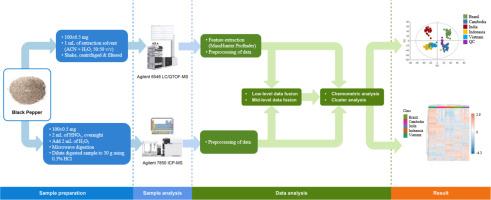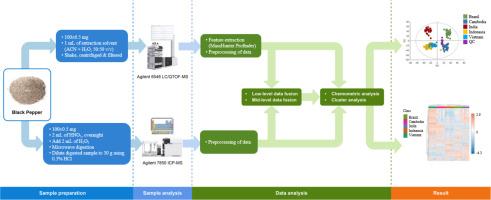A combined elementomics, metabolomics, and chemometrics approach as tools to identify the geographic origins of black pepper
IF 9.8
1区 农林科学
Q1 CHEMISTRY, APPLIED
引用次数: 0
Abstract
Black pepper is one of the most widely used spices with high market value globally. Its supply chains complexity and economic value predispose it to fraud. Determining the provenance of this spice is imperative to protect all stakeholders in the value chain. We explored elementomics, untargeted metabolomics, and chemometrics approaches in tracing geographical origin of black pepper. A total of 150 black pepper samples were collected from five countries (Brazil, Cambodia, India, Indonesia, Vietnam) and analysed using ICP-MS and LC/QTOF-MS to obtain elemental and chemical fingerprints of the samples, respectively. Chemometric techniques were used for the multivariate analysis to discriminate and classify samples' origins. Further geographical differentiation was carried out by applying a data fusion approach. ICP-MS demonstrated 85% classification accuracy while LC/QTOF-MS and data fusion approach gave 100% discrimination rate. Our findings provide empirical evidence for combined elementomics, metabolomics, and chemometrics techniques for black pepper authentication toward fraud prevention.


结合元素组学、代谢组学和化学计量学方法来确定黑胡椒的地理起源
黑胡椒是世界上应用最广泛、市场价值最高的香料之一。其供应链的复杂性和经济价值使其容易发生欺诈。确定这种香料的来源是必要的,以保护价值链中的所有利益相关者。我们探索了元素组学、非靶向代谢组学和化学计量学方法来追踪黑胡椒的地理起源。从5个国家(巴西、柬埔寨、印度、印度尼西亚、越南)采集了150份黑胡椒样品,分别采用ICP-MS和LC/QTOF-MS分析了样品的元素指纹图谱和化学指纹图谱。化学计量学技术用于多变量分析,以区分和分类样品的来源。通过应用数据融合方法进行进一步的地理区分。ICP-MS的分类准确率为85 %,LC/QTOF-MS和数据融合方法的分类准确率为100 %。我们的研究结果为结合元素组学、代谢组学和化学计量学技术进行黑胡椒认证以防止欺诈提供了经验证据。
本文章由计算机程序翻译,如有差异,请以英文原文为准。
求助全文
约1分钟内获得全文
求助全文
来源期刊

Food Chemistry
工程技术-食品科技
CiteScore
16.30
自引率
10.20%
发文量
3130
审稿时长
122 days
期刊介绍:
Food Chemistry publishes original research papers dealing with the advancement of the chemistry and biochemistry of foods or the analytical methods/ approach used. All papers should focus on the novelty of the research carried out.
 求助内容:
求助内容: 应助结果提醒方式:
应助结果提醒方式:


